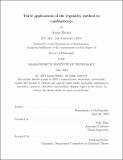Three applications of the regularity method in combinatorics
Author(s)
Berger, Aaron
DownloadThesis PDF (808.6Kb)
Advisor
Zhao, Yufei
Terms of use
Metadata
Show full item recordAbstract
Szemerédi’s regularity lemma is one of the central tools in extremal graph theory and additive combinatorics. We present three versions of this lemma tailored for three applications. The first application considered is the graph removal lemma, which states that for any graph 𝐻 on 𝑘 vertices and all 𝜖 > 0, there is some 𝛿 > 0 such that any graph 𝐺 on 𝑛 vertices and fewer than 𝛿𝑛ᵏ copies of 𝐻 can be made 𝐻-free by deleting at most 𝜖𝑛² edges. The dependence of 𝛿 on 𝜖 in this lemma is of much interest. The current record is due to Fox, who showed that one can take 𝛿⁻¹ to be an exponential tower [mathematical notation] of height 𝑂ₖ(log(𝜖⁻¹)). We give a new proof of these tower-log bounds, simplifying the iterative step by replacing Fox’s mean-entropy density with a new concept called edge budgets.
The remaining two applications of regularity we present are popular differences results. For a compact abelian group 𝐺, a corner in 𝐺 × 𝐺 is a triple of points (𝑥, 𝑦), (𝑥, 𝑦 + 𝑑),(𝑥+𝑑, 𝑦). The classical corners theorem of Ajtai and Szemerédi implies that for every 𝛼 > 0, there is some 𝛿 > 0 such that every subset 𝐴 ⊂ 𝐺×𝐺 of density 𝛼 contains a 𝛿 fraction of all corners in 𝐺×𝐺, as 𝑥, 𝑦, 𝑑 range over 𝐺. However, in general one cannot take 𝛿 polynomially large in terms of 𝛼. Generalizing a result of Mandache from the finite field setting, we show that for any 𝐴 ⊂ 𝐺 × 𝐺 of density 𝛼, there is some “popular difference” 𝑑₀ ≠ 0 such that 𝐴 contains 𝛼⁴ of all corners as 𝑥, 𝑦 vary over 𝐺 but 𝑑 = 𝑑₀ is fixed.
We conclude with a similar result for a more general class of two-dimensional patterns. The following combinatorial conjecture arises naturally from recent ergodic-theoretic work of Ackelsberg, Bergelson, and Best. Let 𝑀₁, 𝑀₂ be 𝑘 × 𝑘 integer matrices, 𝐺 be a finite abelian group of order 𝑁, and 𝐴 ⊆ 𝐺ᵏ with |𝐴| ≥ 𝛼𝑁ᵏ. If 𝑀₁, 𝑀₂, 𝑀₁ − 𝑀₂, and 𝑀₁ + 𝑀₂ are automorphisms of 𝐺ᵏ, is it true that there exists a popular difference 𝑑 ∈ 𝐺ᵏ ∖ {0} such that
#{𝑥 ∈ 𝐺ᵏ : 𝑥, 𝑥 + 𝑀₁𝑑, 𝑥 + 𝑀₂𝑑, 𝑥 + (𝑀₁ + 𝑀₂)𝑑 ∈ 𝐴} ≥ (𝛼⁴ − 𝑜(1))𝑁ᵏ.
We show that this conjecture is false in general, but holds for [equation] with 𝑝 an odd prime given the additional spectral condition that no pair of eigenvalues of 𝑀₁𝑀₂⁻¹ (over the algebraic closure [notation]) are negatives of each other. In particular, the “rotated squares” pattern does not satisfy this eigenvalue condition, and we give a construction of a set of positive density in [notation] for which that pattern has no nonzero popular difference. This is in surprising contrast to three-point patterns, which we handle over all compact abelian groups and which do not require additional spectral conditions.
Date issued
2023-06Department
Massachusetts Institute of Technology. Department of MathematicsPublisher
Massachusetts Institute of Technology